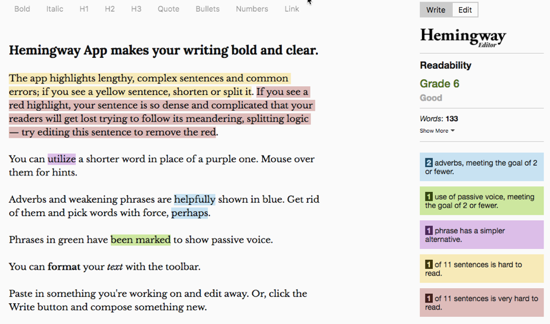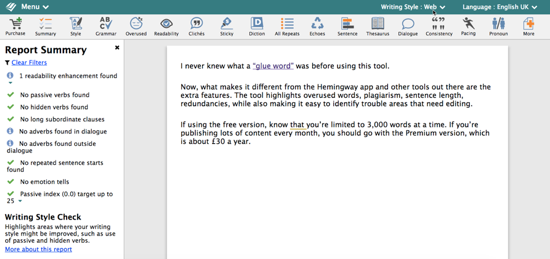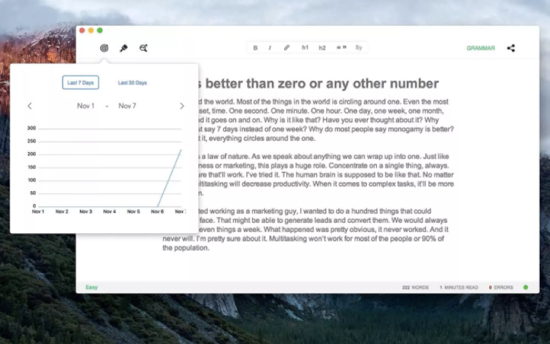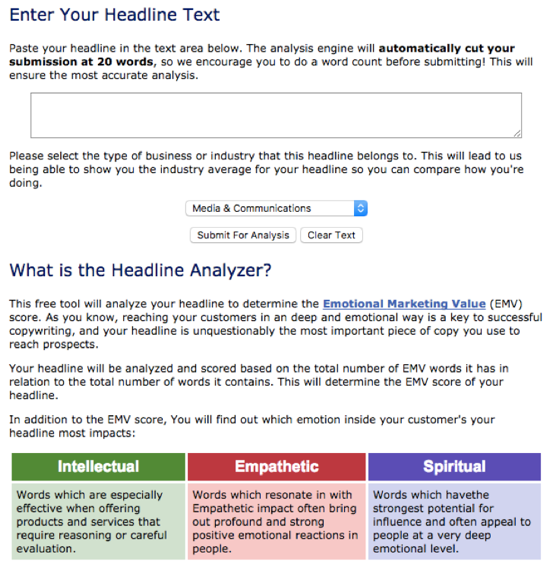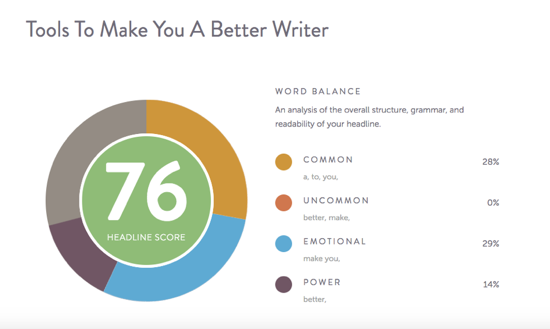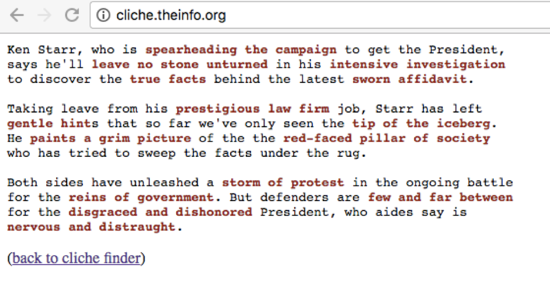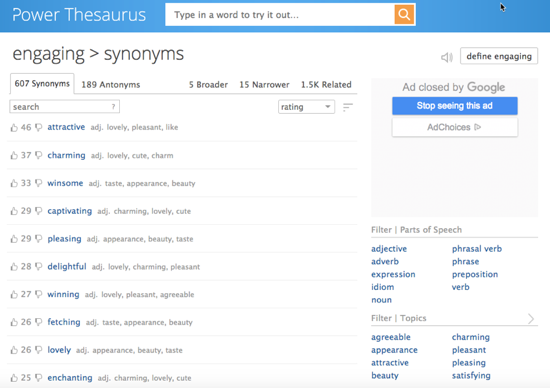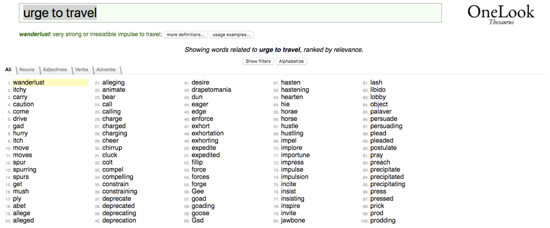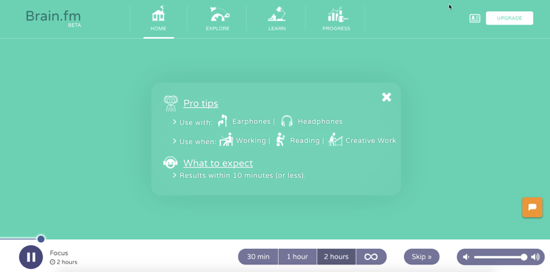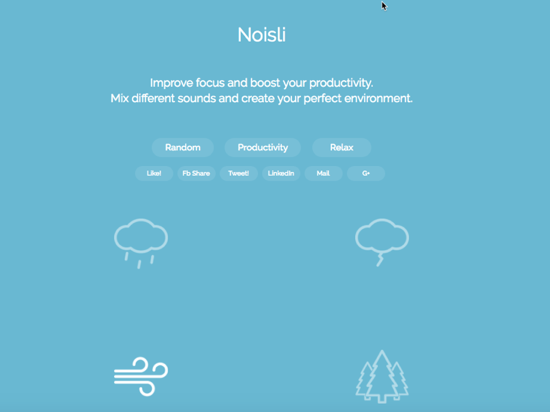10+ tools to make you a better writer
Writing blog posts, copy for your website, sales pages, tweets – it’s all hard. Words are hard. It takes practice to reach that point where you can string words together in a way that makes sense, sounds good, and makes readers feel something.
But here’s the thing: every small business owner, regardless of skills or background, can and should learn how to write. All you need is a little help. And this help comes in the form of writing and editing tools that can assist you in expanding your vocabulary, getting valuable feedback and practising.
While there’s an endless array of tools online, here is a list of the most useful ones (some of which I’m using as well) that’ll turn you into a better writer faster than you can say, “How did I ever live without them?”
10+ tools to improve your writing
1. Hemingway App
This free editing app is fabulous and I highly recommend you use it to make your content more easily readable.
What makes it so great is the fact that it doesn’t try to solve your writing problems; it just highlights them so you can then do your thing.
To use it, all you need to do is go to the app page and paste your text. First, it’ll grade it and highlight the areas that need to be edited. Then it’ll suggest how to improve it.
As you can see, it highlights areas using different colours. Read means the text is very difficult to read, yellow means hard to read, etc.
Hemingway is one of my favourite apps, and it’s definitely one of the best ones for learning how to write effectively.
2. ProWritingAid
What makes ProWritingAid different from the Hemingway app and other tools out there are the extra features. The tool highlights overused words, plagiarism, sentence length, redundancies, while also making it easy to identify trouble areas that need editing.
When using the free version, know that you’re limited to 3,000 words at a time. If you’re publishing lots of content every month, you should go with the Premium version, which is about £30 a year.
Here’s an example of what ProWritingAid looks like in action:
3. Grammarly
What’s great about Grammarly is that if you add the free Chrome plug-in it checks everything you write online in real-time, including tweets and Facebook status updates.
It also gives you synonym suggestions to help you avoid repeating the same word multiple times in a sentence. Plus, you’ll love the detailed explanations that come with any suggested correction.
Now, while this is a fast proofreading tool that helps you spot grammatical errors, typos and awkward sentences, personally I don’t find it as effective or accurate as ProWritingAid.
4. Refly
This AI-powered smart editor was designed with bloggers, authors, and content marketers in mind. It proofreads your content as you write so you can fix any spelling and grammar mistakes. It also gives you synonym suggestions that might speak better to your specific audience.
The tool has an integrated search engine optimisation tool that works by suggesting the keywords to add to your content to optimise it for search engines.
And another cool feature is the goal tracking feature where you get to set a daily writing goal so you can develop a writing habit and improve your skills.
5. Atomic AI
Unlike other tools, the Atomic AI (also known as AtomicWriter) grades your writing based on your specific audience’s reading level and which content they relate to the most.
To do that it pulls insights from your readers’ behaviour (by looking at the data and engagement rated from your Google Analytics and social media accounts) so it can determine who your audience is.
Then it guides you through the editing process so your content is relevant and engaging for your readers. Basically, it makes recommendations to improve anything from length of the post to spelling and grammar, emotion and word complexity.
Atomic AI is available as a Chrome extension, WordPress plugin and web app.
6. EMV Headline Analyzer
The EMV Headline Analyzer allows you to check the emotional marketing value of your headline. Basically, it analyses your headline to see what percentage of words in it evoke emotion. Obviously, the higher, the better.
To use it, you simply paste your headline into the text box, select the relevant industry and click “submit for analysis”.
7. CoSchedule Headline Analyzer
The CoSchedule Headline Analyzer is a bit different, in that it evaluates your headline based on how it will rank in the search engine results. It also considers how well it can perform in social shares and click-throughs.
Here’s how the results look:
Oh, and it also gives you resources with tips that can help you improve your headlines.
8. Cliché Finder
In his six rules for writing, George Orwell advised, “Never use a metaphor, simile, or other figures of speech which you are used to seeing in print.”
So if you think you may have unleashed too many clichés in your latest piece of content, this tool can come in handy.
Simply copy and paste your text, and the tool will highlight any clichés you might’ve missed.
Then you can replace them with more specific text.
9. Thesaurus.com, Power Thesaurus and OneLook Thesaurus
No writer should be without a trusty thesaurus in the next tab.
Thesaurus.com should be your go-to source when you’re writing anything from blog posts to content for your website. It’s essential at helping you to improve your vocabulary and your writing.
Power Thesaurus is another good source that provides you with alternative word choice crowdsources from a community of writers. You’ll love it because there are lots of suggestions to choose from to make your content unique and engaging.
OneLook Thesaurus also has a “reverse dictionary” feature. Here’s how it works: you type in a definition or a group of words related to the word you’re searching for, and you’re then served with the right word for your piece. Perfect for when you’re in that frustrating “what’s the word for this?” moment.
And another cool thing about it is that you can click on a word to see its definition, examples of how that word is used and what other words rhyme with it (just in case you feel inspired to write a poem).
10. Twinword Writer
If you get stuck on a word and don’t want to lose your focus by going to your browser and running searches (which almost always lands you on YouTube or Facebook), you can use a tool like Twinword Writer.
Here’s how it works: when you write and then pause for a few seconds, it’ll automatically sense that you’re stuck on a word. So it will quickly analyse the context of your text and open a box with word suggestions you can choose from. You can also click any word to get suggestions.
11. Brain.fm and Noisli
Writing is hard. But what’s harder is to get in the zone and keep that focus, without letting yourself get distracted by an email or social media notification.
Brain.fm is an app that can help boost your productivity so you get writing done.
Noisli is another alternative. It allows you to choose and/ or combine different background sounds so you can find just the right one that works best for you.
For example, if you’re working from home and the workplace or coffee shop noise improves your focus, with Noisli they’re one click away.
Wrapping up
No matter what business you’re in, honing your writing skills is always useful. Especially if you’re on a budget and can’t always afford to hire a specialist to write content for your website or blog. Hopefully, the tools listed above will help you to become a better writer.
Are you using other tools that have helped you improve your writing? Tweet us your best ones @123Reg.

